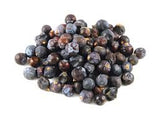What Is In My Gin? #1 Juniper
We are discovering from our visitors that, while a majority are aware that gin is a spirit flavoured with botanicals, most want to know a bit more about those individual ingredients.

Juniper is the predominant botanical (and the one from which gin gets its name) we think it is logical that we start our journey through the botanicals with this “berry”.
Firstly, let’s dispense with the notion that this is a berry. It is actually a female seed cone produced by the juniper tree. For a cone it has an unusual quality in that it is fleshy and has merged scales. The scales give the cone a berry look and hence the name.
The berries are pungent, have a fresh, woody, pine-needle odour and take two - three years to ripen from green in colour to a deep purple. Those used in making gin come from the Juniperus Communis (Common Juniper) which grows throughout the Northern Hemisphere.
The berries are not only used to flavour gin. In the kitchen mature they are used to flavour game as well as stuffing, marinades and stews. Authentic sauerbraten or sauerkraut can’t be made without juniper berries.
In herbal medicine, juniper has been used as a carminative and as a steam inhalant in the management of bronchitis and the berries are said to stimulate the appetite and to serve as a cleansing tonic to the digestive system. They were also often eaten to relieve rheumatism or to freshen bad breath.
 For those interested in folk lore, Juniper has come to symbolize protection. Legend has it that juniper planted beside the front door will keep witches out; the only way for a witch to get past the plant was by correctly counting its needles.
For those interested in folk lore, Juniper has come to symbolize protection. Legend has it that juniper planted beside the front door will keep witches out; the only way for a witch to get past the plant was by correctly counting its needles.







